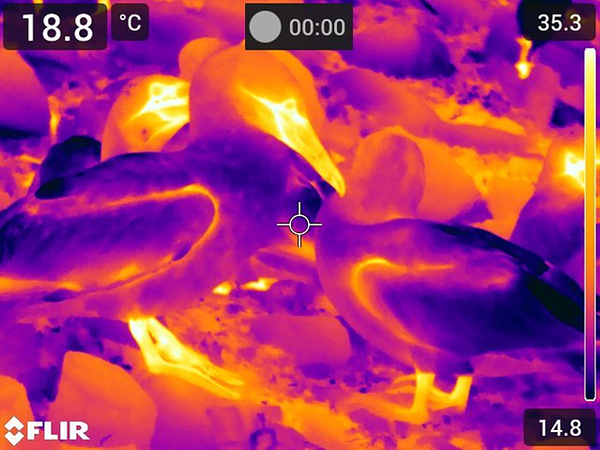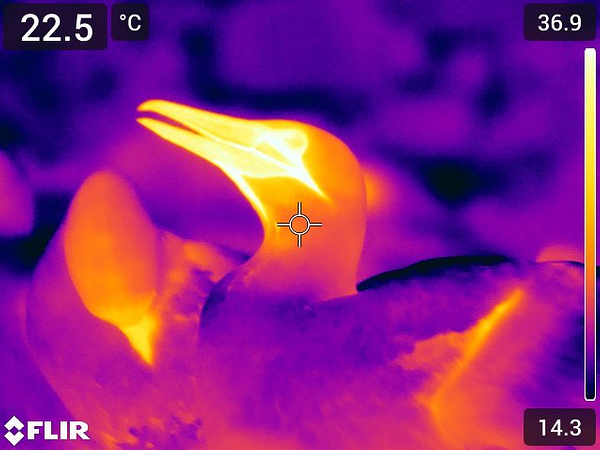_James_Glossop.JPG)
When is it too Hot for a Seabird?
Research Spotlight: Are Northern gannet chicks heat stressed?
By Dr Ruedi Nager
This brilliant blog is part of our research spotlight series. For context around this project, read the previous blog here or go to our Bass Rock Research webpage.
We are living in a warming world. According to the Met Office, the summer of 2022 was the fourth hottest summer in the UK for daily average temperature since records began in 1884, with temperatures reaching over 40°C. Only the summers of 2003, 2006 and 2018 were warmer than 2022, and we have already seen another record-breaking heat wave in summer 2023. Although it’s nice to have sunny and hot summer days, the experience of record-breaking temperatures has also reminded us of the associated risks for human health, in particular for vulnerable people. But is it only humans suffering from high temperatures? Wildlife also experiences these extreme temperatures and might be adversely affected.
We think that our seabirds in particular could be negatively affected by extreme temperatures. Some seabird prey animals (fish) don’t fare well in warming waters, reducing the amount of food they can find. But high temperatures may also affect the seabirds directly. Imagine a guillemot or Northern gannet sitting in their nest on a barren rocky coast; they defend a very small and cozy territory densely surrounded by many neighbours. These birds spend a lot of time in cold water, and they are superbly insulated to retain their precious body heat under cold conditions.
SusanDavies_(7).jpeg)
This insulation could be compared to wearing a thick, warm coat. When the sun comes out, there is no moving away because the territory is tiny, and there is no shade in reach. Taking off the ‘warm coat’ is not an option. You can imagine how hot this might feel, even before the temperature reaches 40°C. Is that what our seabirds are facing? To find out we (Jana Jeglinski, Shannon Clifford and I, with the kind support of the Seabird Centre) set off to Bass Rock for the 2022 Northern Gannet breeding season.
The aim was to assess whether Northern Gannets suffer from high temperatures. Birds, like humans, should usually be able to keep their body temperature within a set limit. However, if the environment gets too hot the body can’t keep its temperature within the normal range and it rises, causing heat stroke. As birds regulate their body temperature within narrow limits, their body temperature is a good measure of their health and how they cope with the environment.
We can routinely measure our body temperature by putting a thermometer under our tongue. But taking the body temperature of birds is a lot more difficult than assessing a willing human patient. Or at least used to be. With the recent development of better and more affordable thermal cameras it is now possible for field ecologists to measure a bird’s body temperature remotely by taking thermal images with little disturbance to the bird. Instead of showing the visible light like normal cameras, thermal cameras record thermal radiation in the infrared range (just above the visible light spectrum).
All bodies reflect radiation that is proportional to the body’s temperature. There is a physical law that relates emitted radiation to the body’s temperature. To visualise the temperature, the radiation reading at each pixel of the image is translated into a colour and used to produces a false colour image (Figure 1). One colour represents warmer temperatures and another colour represents cooler temperatures; the colours for cooler and warmer temperatures can be chosen by the user, and so images can differ in what colour gradient is used. We can thus use a thermal image to assess a bird’s body temperature.

Body temperatures varies from higher temperatures at the core of the body (where heat is produced by the inner organs and muscles) to cooler temperatures at the surface (where heat is lost to the surrounding environment). The thermal camera picks up just the surface temperature. On the body of a bird the surface temperature will vary. For example, areas covered with feathers appear cooler because the plumage forms a very effective insulation layer and reduces the loss of heat (Figure 1).
When a seabird is exposed to sunshine, the radiation will warm up the body and the body will need to dump excess heat. If they don’t, the temperature in the core of the body will increase which ultimately can have fatal consequences. How can a body dump heat? We sweat, and the evaporation of the sweat will cool down the body’s surface and we lose heat. However, birds don’t sweat like us. Instead, Northern Gannets can breathe more quickly (panting) and in addition they vibrate their throat tissue (called gular fluttering) which promotes heat loss analogous to us sweating (Figure 2). However, panting and gular fluttering is a costly way of removing excess heat as it is expensive in terms of energy, as well as precious water which can be in short supply in hot weather (seabirds are surrounded by the sea- not freshwater!).

To avoid the ‘costs’ associated with panting and gular fluttering, birds can also dump excess heat through un-feathered areas like their legs and beak. See the bright yellow colour in Figure 1, indicating how warm these areas are. These are exquisite thermal radiators through which the birds can dump excess heat without paying the cost in energy and water required for panting and gular fluttering. In order to act as thermal radiators these body regions need to have anatomical structures, allowing the flow of warm blood to be diverted to the surface so they can dump the heat. The thermal images allow us to estimate the amount of heat transfer; the warmer the air temperature the more heat will be dumped.
Some other body regions that are small and un-feathered are not used as thermal radiators, but they can give us a window to the core temperature. For example, the skin around the eye is un-feathered and its temperature is correlated with the core body temperature. So, by measuring the temperature of the eye region we expect to see a constant temperature for the birds that can successfully regulate their body temperature within its limits. However, at high air temperatures when the birds can’t dump enough heat, we would expect the eye region temperature to go up.
Ideally, we don’t want to see these types of temperature increases, as it indicates that the birds can no longer cope with the hot weather. However, eye region temperature is only a good indicator of core temperature if the bird is as undisturbed as possible; if it is stressed by our presence, it will divert blood away from the surface including the eye region (the equivalent of us going pale when frightened) and the eye region temperature will drop. So, when we are on Bass Rock, we will need to disturb the birds as little as possible.
This hopefully provides an insight into how thermal imaging allows us to assess whether Northern Gannets can cope with hot weather. However, in order to properly assess whether gannets are heat stressed, we also needed to know exactly how hot the tiny territories that each bird occupies becomes. This challenge will be explored in our final blog HERE.
- Header Image Copyright: James Glossop

